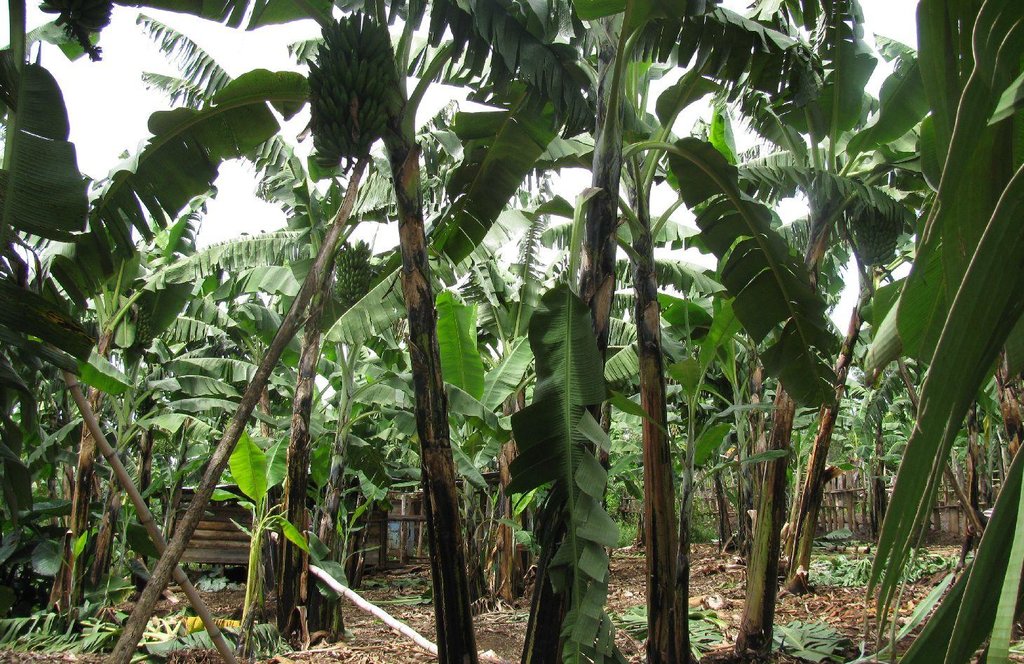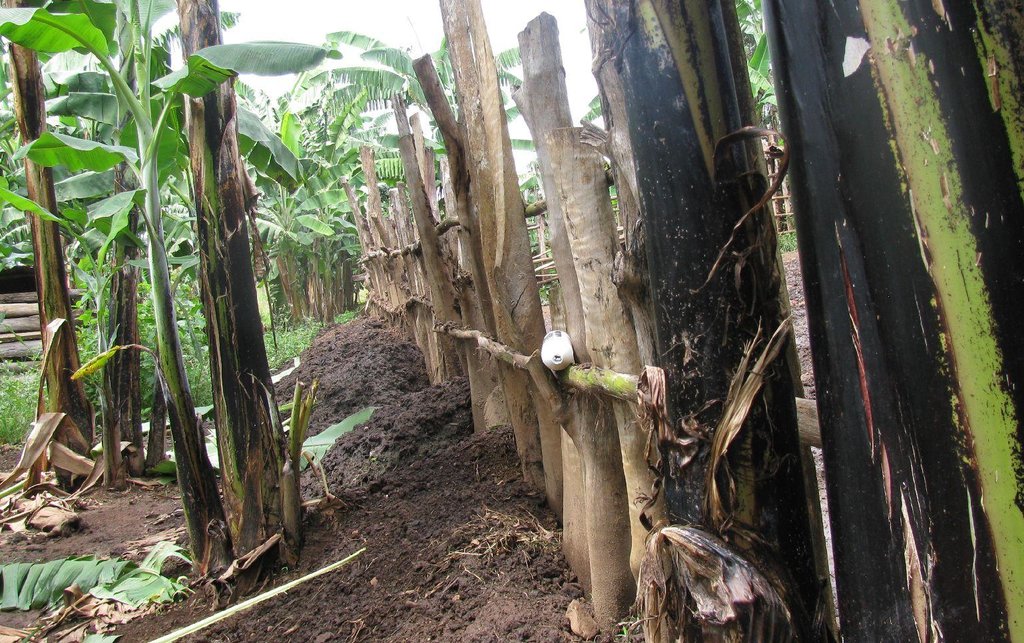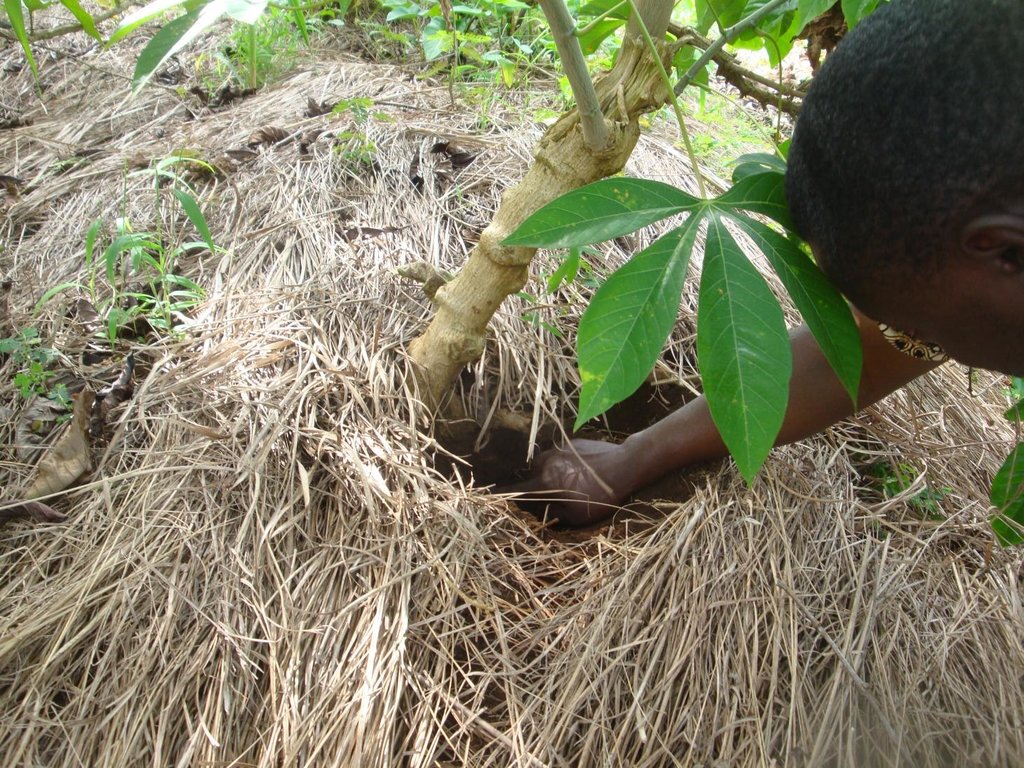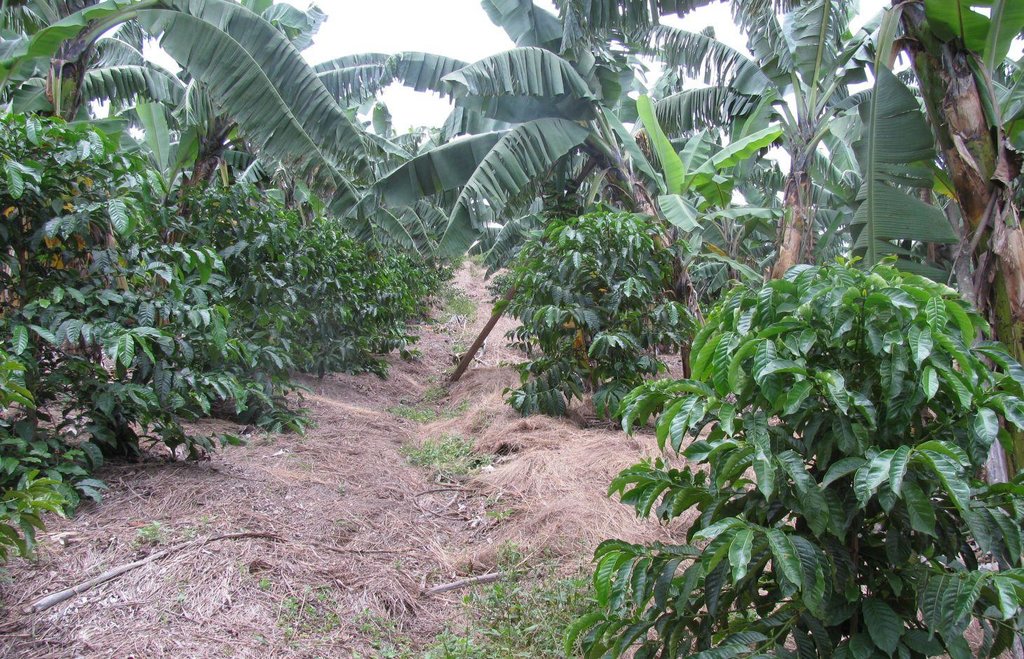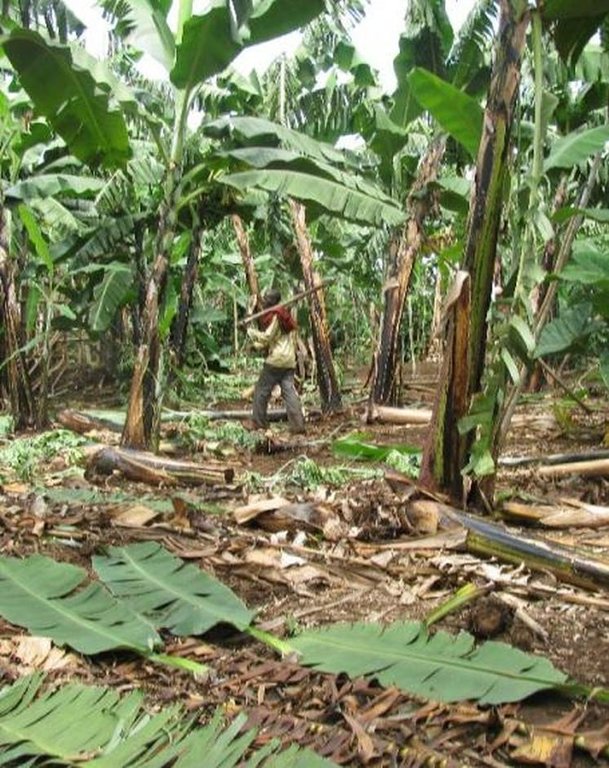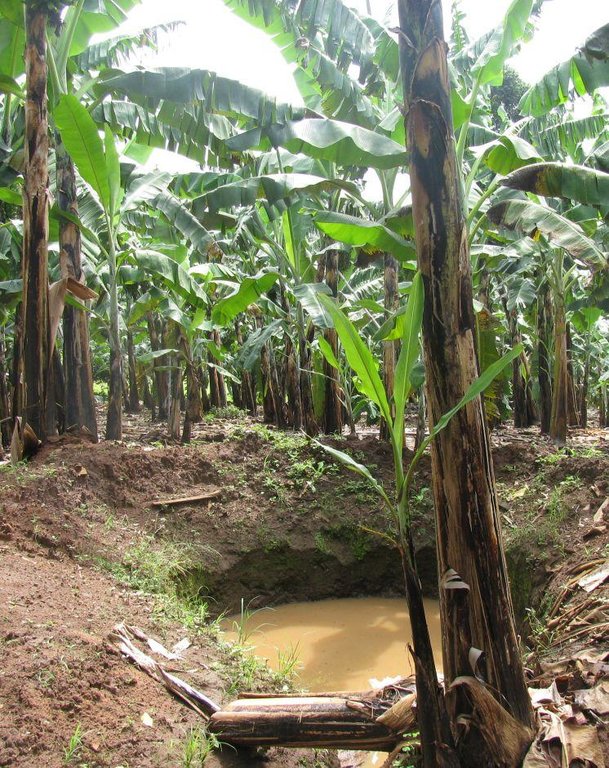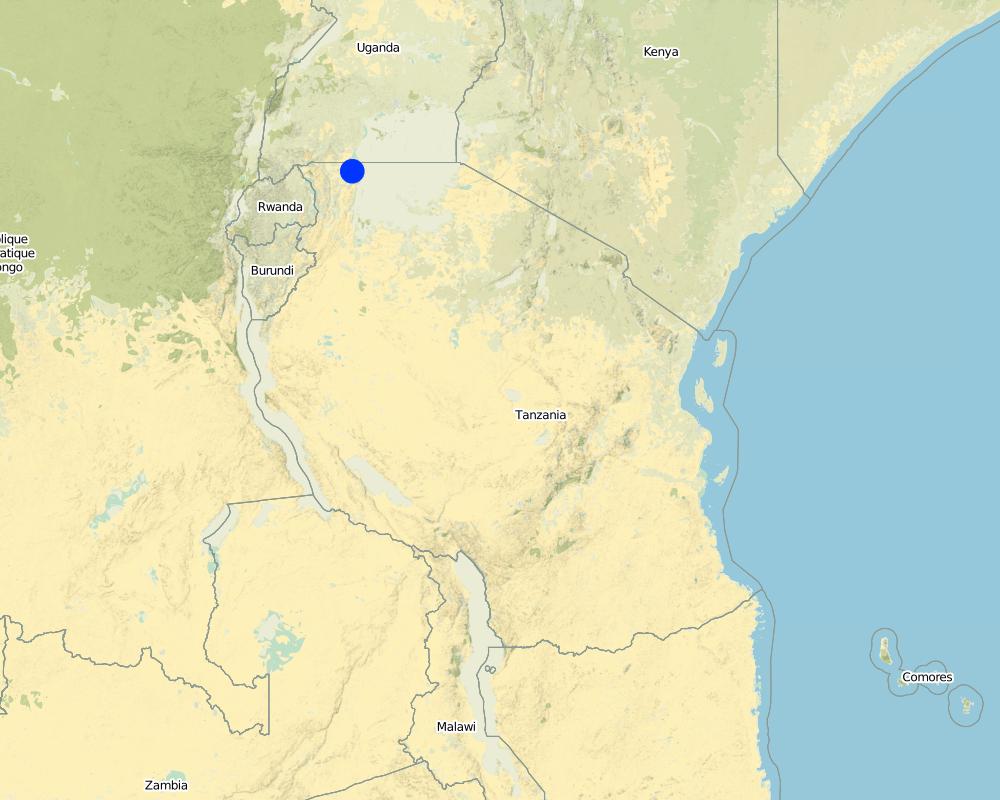Improved Kibanja cropping system [Tanzania, United Republic of]
- Creation:
- Update:
- Compiler: Jasson Rwazo
- Editor: –
- Reviewer: David Streiff
Ekibanja ekiine emikolele emirungi (Haya/Nyambo)
technologies_1183 - Tanzania, United Republic of
View sections
Expand all Collapse all1. General information
1.2 Contact details of resource persons and institutions involved in the assessment and documentation of the Technology
Government:
SLM specialist:
Government:
Makung'uto Iddi
Missenyi District Council
Tanzania, United Republic of
Government:
Kagaruki Anna Grace
Missenyi District Council
Tanzania, United Republic of
Government:
Subira John
Missenyi District Council
Tanzania, United Republic of
SLM specialist:
Kaihura Fidelis
+255 754273849
Fidelis.kaihura@fao.org
Kagera TAMP
P.O.Box 127 Bukoba
Tanzania, United Republic of
Government:
Kitundu Elizabeth
Missenyi District Council
P.O.BOX 38 Missenyi
Tanzania, United Republic of
Name of the institution(s) which facilitated the documentation/ evaluation of the Technology (if relevant)
Food and Agriculture Organization of the United Nations (FAO) - ItalyName of the institution(s) which facilitated the documentation/ evaluation of the Technology (if relevant)
Kagera Transboundary Agro-ecosystem Management (K-TAMP) - Tanzania, United Republic ofName of the institution(s) which facilitated the documentation/ evaluation of the Technology (if relevant)
Missenyi District Council (Missenyi District Council) - Tanzania, United Republic of1.3 Conditions regarding the use of data documented through WOCAT
When were the data compiled (in the field)?
11/07/2012
The compiler and key resource person(s) accept the conditions regarding the use of data documented through WOCAT:
Yes
2. Description of the SLM Technology
2.1 Short description of the Technology
Definition of the Technology:
This is a traditional banana and coffee complex cropping system interplanted with annual crops, trees,shrubs, vegetables and other diverse plants of social economic importance.
2.2 Detailed description of the Technology
Description:
Improved traditional multi-cropping system that combines banana and coffee as main crops planted in a specific spacing to optimize plant stands. Banana and coffee are intercropped with; 1. annuals crops: Maize, beans, yams, coco-yams;2. Vegetables: Lycoperscum esculentum, Amaranthus spp, Cucumis communis and Solanum aethopium ;3. Shrubs of social economic value. Trees (e.g Maesopsis eminii, Makhcamia lutea, Ricinus comunis, Ficus thorninghii) and shrubs (Dracaena usambarensis) are planted on the farm edge. These serve as live fence, wind breaker, source of timber, fuel wood, medicine and protect the field against erosion. To optimize farm production, application of 15cm thick mulch ( grass mulch and banana prunnings), farmyard or compost manure and interplanting with soil fertility and/or soil moisture improvement trees are ensured. With problems of climate change, water harvesting ditches and trenches are constructed. Water harvesting ditches are constructed to collect water from micro catchments like roads or homestead. Sustainability of the Improved Kibanja system has always been assured through crop/livestock integration approaches.The cropping system is typical in high rainfall areas along foot slopes, valley bottoms or hilltops preferably on fertile and deep soils.
Purpose of the Technology: The purpose is improve soil fertility,moisture, controlling soil erosion (wind and water) and suppressing weeds in order to improve the production banana, coffee and other inter planted crops.
Establishment / maintenance activities and inputs: Establishment activities: 1. Land clearing and preparation: Slashing, uprooting tree stumps, ploughing and pitting 60cm x 90cm banana hole and 60cm x 60cm coffee (Mid June to August) using simple farm implements; 2.Farm Yard Manure application: 60 Kg per banana holes and 36 Kg per coffee hole (August to early September); 2. Planting: 308 banana suckers at 3.6m x 8m spacing, 830 coffee seedlings at 3m x 8m spacing in alternating row, edge row trees seedling at 10m spacing and 15cm spacing for shrubs e.g. Dracaena usambarensis (September to November);4. Excavation of water retention structure ( after planting mainly in Novermber). Full establishment of Improved Kibanja cropping system can be attained in three years.
Maintenance activities:1. Weeding:Done two times per year (mid January to February / July to augost) before planting annual crops; 2.FYM enrichment: Every after 3 years; iii. banana dethrashing and desuckering ,topping mulch, coffee pruning and harvesting (Immediately after weeding); 4. Other maintenence activities: Disease control (nematode, banana weevils, Banana Xanthamonas Wilt) and Propping (using pole to support banana plant with heavy bunches against wind); 5.Inputs: Labour, farmyard manure, propping poles, mulch; 6. Simple farm implements:Hand hoe,machete and wheel barrow.
Natural / human environment: The technology is implemented in mixed land use type under sub humid condition receiving 1000-1500mm of rains per year. A combination of soil and water improvement measures (FYM application, Mulching, water retention ditches and live fencing) complement each other to minimize risk of crop failure and hence improve production. The slope is gentle to moderate , soil depth is moderate and soil texture loam. Simple hand tools are traditional used,Land ownership is individual not titled. Application of this technology determined by high establishment and maintenence cost.
2.3 Photos of the Technology
2.5 Country/ region/ locations where the Technology has been applied and which are covered by this assessment
Country:
Tanzania, United Republic of
Region/ State/ Province:
Tanzania
Further specification of location:
Missenyi District, Kyazi Village
Map
×2.6 Date of implementation
If precise year is not known, indicate approximate date:
- less than 10 years ago (recently)
2.7 Introduction of the Technology
Specify how the Technology was introduced:
- through projects/ external interventions
Comments (type of project, etc.):
Improved traditional land use system: The use of combination of measures in Improved Kibanja Cropping system in Kagera has been existing for more than 100 year ago.
3. Classification of the SLM Technology
3.1 Main purpose(s) of the Technology
- improve production
- reduce, prevent, restore land degradation
- improve soil fertility
3.2 Current land use type(s) where the Technology is applied

Mixed (crops/ grazing/ trees), incl. agroforestry
- Agro-silvopastoralism
Main products/ services:
Ficus thoninji,Markhamia lutea,Maesopesis eminii
major cash crop: Beans, banana and avocado
major food crop: Beans and banana
Comments:
Major land use problems (compiler’s opinion): Soil nutrient loss, decline of soil moisture and soil erosion by wind and fast water runoff.
Major land use problems (land users’ perception): Reduced crop production, loss of indigenous medicinal plants, reduced water water quatity in natural water sources.
Type of cropping system and major crops comments: Due to mixed farming and agroforestry there is high nutrient cycling resulting in high productivity
3.3 Further information about land use
Water supply for the land on which the Technology is applied:
- rainfed
Number of growing seasons per year:
- 2
Specify:
Longest growing period in days: 120; Longest growing period from month to month: Short rains (September to December); Second longest growing period in days: 65; Second longest growing period from month to month: Long rains (March to June)
Livestock density (if relevant):
1-10 LU /km2
3.4 SLM group to which the Technology belongs
- agroforestry
- windbreak/ shelterbelt
- water harvesting
3.5 Spread of the Technology
Specify the spread of the Technology:
- evenly spread over an area
If the Technology is evenly spread over an area, indicate approximate area covered:
- < 0.1 km2 (10 ha)
Comments:
Total area covered by the SLM Technology is 0.062 km2.
2ha approximately
3.6 SLM measures comprising the Technology

agronomic measures
- A2: Organic matter/ soil fertility

vegetative measures
- V1: Tree and shrub cover
- V2: Grasses and perennial herbaceous plants

structural measures
- S4: Level ditches, pits

management measures
- M3: Layout according to natural and human environment
Comments:
Secondary measures: management measures
Type of agronomic measures: mixed cropping / intercropping, retaining more vegetation cover, mulching, manure / compost / residues, minimum tillage, pits
Type of vegetative measures: aligned: -against wind, aligned: -along boundary, aligned: -linear
3.7 Main types of land degradation addressed by the Technology

soil erosion by water
- Wt: loss of topsoil/ surface erosion

chemical soil deterioration
- Cn: fertility decline and reduced organic matter content (not caused by erosion)

biological degradation
- Bc: reduction of vegetation cover
Comments:
Main causes of degradation: soil management (Cultivation along the slope and overcultivation), crop management (annual, perennial, tree/shrub) (Cultivation of season crop without reprenishing of soil nutrients), change of seasonal rainfall (Fractuation in rain season), droughts, population pressure, education, access to knowledge and support services
Secondary causes of degradation: Heavy / extreme rainfall (intensity/amounts), land tenure, poverty / wealth, inputs and infrastructure: (roads, markets, distribution of water points, other, …)
3.8 Prevention, reduction, or restoration of land degradation
Specify the goal of the Technology with regard to land degradation:
- prevent land degradation
- reduce land degradation
Comments:
Secondary goals: mitigation / reduction of land degradation
4. Technical specifications, implementation activities, inputs, and costs
4.1 Technical drawing of the Technology
Author:
Jasson Rwazo, P.O.BOX 38 Misseny Tanzania, rjrwazo@gmail.com
4.2 Technical specifications/ explanations of technical drawing
Location: Kyazi Village. Missenyi District, Kagera Region, Tanzania
Date: 2012.08.28
Technical knowledge required for field staff / advisors: moderate (The technology requires moderate technical knowledge for adoption)
Technical knowledge required for land users: moderate (The technology requires moderate technical knowledge for adoption)
Main technical functions: control of raindrop splash, control of dispersed runoff: retain / trap, control of concentrated runoff: retain / trap, improvement of ground cover, increase in organic matter
Secondary technical functions: increase in nutrient availability (supply, recycling,…), increase of infiltration, water harvesting / increase water supply, reduction in wind speed, increase of biomass (quantity)
Mixed cropping / intercropping
Material/ species: Banana
Quantity/ density: 304
Remarks: 3.6 m by 8m
Retaining more vegetation cover
Material/ species: Beans
Remarks: Random
Mulching
Material/ species: Grass mulch, banana(Prooning) trashes mulch
Quantity/ density: 10000
Remarks: Spreading the mulch
Material/ species: Coffee
Quantity/ density: 830
Remarks: 3m by 8m
Manure / compost / residues
Material/ species: Farmyard manure, farm residure,
Quantity/ density: 40 tone
Remarks: Spreading on the pit
Minimum tillage
Material/ species: Hand hoe,matechette
Pits
Material/ species: Hand hoe,matechette
Aligned: -against wind
Vegetative material: T : trees / shrubs
Number of plants per (ha): 277
Vertical interval between rows / strips / blocks (m): Random
Spacing between rows / strips / blocks (m): Random
Vertical interval within rows / strips / blocks (m): Random
Width within rows / strips / blocks (m): 6
Aligned: -along boundary
Vegetative material: T : trees / shrubs
Number of plants per (ha): 100000
Vertical interval between rows / strips / blocks (m): 0.01
Width within rows / strips / blocks (m): 0.01
Aligned: -linear
Vegetative material: T : trees / shrubs
Number of plants per (ha): 100000
Vertical interval between rows / strips / blocks (m): 0.01
Width within rows / strips / blocks (m): 0.01
Trees/ shrubs species: Maeesopsis Eminii, Dracaena usambalensis,Erythrina abysinica
Fruit trees / shrubs species: Pawpaw, Orange, Avocado
Perennial crops species: Banana, Coffee, Vanilla
Other species: Carisa edulis (shrubs)
Slope (which determines the spacing indicated above): 6.3%
Gradient along the rows / strips: 6.3%
Diversion ditch/ drainage
Vertical interval between structures (m): 0.4
Spacing between structures (m): 6
Depth of ditches/pits/dams (m): 0.3
Width of ditches/pits/dams (m): 0.3
Length of ditches/pits/dams (m): 3
Height of bunds/banks/others (m): 0.15
Width of bunds/banks/others (m): 0.15
Length of bunds/banks/others (m): 3
Waterway
Vertical interval between structures (m): 0.4
Spacing between structures (m): 6
Depth of ditches/pits/dams (m): 0.75
Width of ditches/pits/dams (m): 1.5
Length of ditches/pits/dams (m): 2
Height of bunds/banks/others (m): 0.3
Width of bunds/banks/others (m): 0.4
Length of bunds/banks/others (m): 5
Retention/infiltration ditch/pit, sediment/sand trap
Vertical interval between structures (m): 0.4
Spacing between structures (m): 6
Depth of ditches/pits/dams (m): 0.75
Width of ditches/pits/dams (m): 1.5
Length of ditches/pits/dams (m): 2
Height of bunds/banks/others (m): 0.3
Width of bunds/banks/others (m): 0.4
Length of bunds/banks/others (m): 5
Construction material (earth): 2.25 m3 of earth material used per ditch
Slope (which determines the spacing indicated above): 6%
Lateral gradient along the structure: 8%
Specification of dams/ pans/ ponds: Capacity 10m3
Catchment area: 1.6Ham2
For water harvesting: the ratio between the area where the harvested water is applied and the total area from which water is collected is: 1:3.5
4.3 General information regarding the calculation of inputs and costs
Specify currency used for cost calculations:
- US Dollars
Indicate average wage cost of hired labour per day:
1
4.4 Establishment activities
| Activity | Type of measure | Timing | |
|---|---|---|---|
| 1. | Land clearing and preparation:Slashing,uprooting tree stumps, ploughing and pitting | June to August | |
| 2. | Availing and applying 54 tone Farm Yard | August to early September | |
| 3. | Planting: 308 banana suckers 830 coffee and tree edge low tree seedlings | From September | |
| 4. | Construction of water harvesting ditches | Structural | Once year |
4.5 Costs and inputs needed for establishment
| Specify input | Unit | Quantity | Costs per Unit | Total costs per input | % of costs borne by land users | |
|---|---|---|---|---|---|---|
| Labour | Land clearing | persons/day | 202.0 | 1.18316 | 239.0 | 100.0 |
| Labour | Construction of water harvesting ditches | persons/day | 4.0 | 0.937 | 3.75 | 100.0 |
| Equipment | Tools | ha | 1.0 | 61.56 | 61.56 | 100.0 |
| Plant material | Seedlings | pieces | 1138.0 | 0.0468 | 53.26 | 100.0 |
| Fertilizers and biocides | Manure | tons | 54.0 | 34.7222 | 1875.0 | |
| Other | Cuttings | ha | 1.0 | 2234.6 | 2234.6 | 100.0 |
| Total costs for establishment of the Technology | 4467.17 | |||||
Comments:
Duration of establishment phase: 36 month(s)
4.6 Maintenance/ recurrent activities
| Activity | Type of measure | Timing/ frequency | |
|---|---|---|---|
| 1. | Topping grass mulch | Agronomic | 3 times per year |
| 2. | Farm yard manure enrichment | Agronomic | 2 times per year |
| 3. | Removal of sediments and debris in water retention ditches. | Agronomic | Every year |
| 4. | To replacement propping Poles | Agronomic | Every 1.5 year |
| 5. | To corve transportation cost | Agronomic | Manure |
| 6. | Replacement of propping pole and live hedges | Vegetative | Every 1.5 year |
| 7. | Removal of sediments and debris in water retention ditches | Structural | Once per year |
4.7 Costs and inputs needed for maintenance/ recurrent activities (per year)
| Specify input | Unit | Quantity | Costs per Unit | Total costs per input | % of costs borne by land users | |
|---|---|---|---|---|---|---|
| Labour | Topping grass mulch | persons/day | 10.0 | 4.101 | 41.01 | 100.0 |
| Labour | Applying FYM | persons/day | 10.0 | 3.906 | 39.06 | 100.0 |
| Labour | Removal of sediments | persons/day | 4.0 | 0.9375 | 3.75 | 100.0 |
| Labour | To replacement propping Poles | persons/day/ha | 10.0 | 3.906 | 39.06 | 100.0 |
| Equipment | Tools | per ha | 4.0 | 1.875 | 7.5 | 100.0 |
| Fertilizers and biocides | Farm yard manure | tons | 20.833 | 46.8 | 974.98 | 100.0 |
| Construction material | Wood | pieces/ha | 600.0 | 0.625 | 375.0 | 100.0 |
| Other | Mulching material | bundle | 300.0 | 1.875 | 562.5 | 100.0 |
| Other | Transportation | trips | 19.0 | 61.673 | 1171.79 | 100.0 |
| Total costs for maintenance of the Technology | 3214.65 | |||||
Comments:
Machinery/ tools: Machetes, Mattocks, Hand hoe, spade, wheel barrow, Machete,Hand hoes, spade, Hand hoe,Machete, Spade
Cost assesment completed in June 2012
4.8 Most important factors affecting the costs
Describe the most determinate factors affecting the costs:
Manure is most determinate factor high transportation cost especially during establishment
5. Natural and human environment
5.1 Climate
Annual rainfall
- < 250 mm
- 251-500 mm
- 501-750 mm
- 751-1,000 mm
- 1,001-1,500 mm
- 1,501-2,000 mm
- 2,001-3,000 mm
- 3,001-4,000 mm
- > 4,000 mm
Specifications/ comments on rainfall:
Avarage rainfall 1200mm, Bimode rainfall, 5 month dry season
Agro-climatic zone
- sub-humid
Thermal climate class: tropics. Annual temperature 23C
Length of growing period 120 -300 days
5.2 Topography
Slopes on average:
- flat (0-2%)
- gentle (3-5%)
- moderate (6-10%)
- rolling (11-15%)
- hilly (16-30%)
- steep (31-60%)
- very steep (>60%)
Landforms:
- plateau/plains
- ridges
- mountain slopes
- hill slopes
- footslopes
- valley floors
Altitudinal zone:
- 0-100 m a.s.l.
- 101-500 m a.s.l.
- 501-1,000 m a.s.l.
- 1,001-1,500 m a.s.l.
- 1,501-2,000 m a.s.l.
- 2,001-2,500 m a.s.l.
- 2,501-3,000 m a.s.l.
- 3,001-4,000 m a.s.l.
- > 4,000 m a.s.l.
Indicate if the Technology is specifically applied in:
- concave situations
Comments and further specifications on topography:
Altitudinal zonation: 1270m a.s.l
Slopes on average: Movement of soil due to erosion, exposure of parent rock on some part of the farm
5.3 Soils
Soil depth on average:
- very shallow (0-20 cm)
- shallow (21-50 cm)
- moderately deep (51-80 cm)
- deep (81-120 cm)
- very deep (> 120 cm)
Soil texture (topsoil):
- medium (loamy, silty)
Topsoil organic matter:
- medium (1-3%)
If available, attach full soil description or specify the available information, e.g. soil type, soil PH/ acidity, Cation Exchange Capacity, nitrogen, salinity etc.
Soil depth on average: Shallow on the hill slope and moderately deep on the valley bottom, also deep sometimes
Soil texture (topsoil): Sandy loam
Topsoil organic matter: Due to the high use of organic manure (farm yard manure) and mulch
Soil fertility is medium
Soil drainage / infiltration is medium due to the high use of organic manure (farm yard manure), mulch, good aeration
Soil water storage capacity is medium due to the high use of organic manure (farm yard manure) and mulch
5.4 Water availability and quality
Ground water table:
> 50 m
Availability of surface water:
medium
Water quality (untreated):
poor drinking water (treatment required)
5.5 Biodiversity
Species diversity:
- medium
Comments and further specifications on biodiversity:
Different species of soil micro organisms and plant species
5.6 Characteristics of land users applying the Technology
Market orientation of production system:
- mixed (subsistence/ commercial
Off-farm income:
- less than 10% of all income
Relative level of wealth:
- average
Individuals or groups:
- individual/ household
Level of mechanization:
- manual work
Gender:
- women
- men
Indicate other relevant characteristics of the land users:
Land users applying the Technology are mainly common / average land users
Difference in the involvement of women and men: The land inheritance is mainly dominated by male, women mostly use the land for production of understory crops such as beans; banana and coffee production is dominated by men
Population density: > 500 persons/km2
Annual population growth: 2% - 3%; 3%
5% of the land users are very rich and own 30% of the land (Own 2.5-5 acre land, car, 10-20 catlle,brick wall house).
15% of the land users are rich and own 20% of the land (Own 1-2.5 acre of land,2-5 cattle, brick wall house).
60% of the land users are average wealthy and own 35% of the land (Own 0.5-1 acre of land,2-3 goats,mud wall house with corrugarated iron roof).
15% of the land users are poor and own 10% of the land (Own 0-0.5 acre of land, no livestock, mud house withgrass roofing).
5% of the land users are poor and own 5% of the land (Does not own land or own less than 0.5 acre of land, work as casual labour).
Off-farm income specification: 90% of land users income depends on on- income
Market orientation of production system: Mainly for substence for commecial
Level of mechanization: Using hand tools
5.7 Average area of land owned or leased by land users applying the Technology
- < 0.5 ha
- 0.5-1 ha
- 1-2 ha
- 2-5 ha
- 5-15 ha
- 15-50 ha
- 50-100 ha
- 100-500 ha
- 500-1,000 ha
- 1,000-10,000 ha
- > 10,000 ha
5.8 Land ownership, land use rights, and water use rights
Land ownership:
- individual, not titled
5.9 Access to services and infrastructure
health:
- poor
- moderate
- good
education:
- poor
- moderate
- good
technical assistance:
- poor
- moderate
- good
employment (e.g. off-farm):
- poor
- moderate
- good
markets:
- poor
- moderate
- good
energy:
- poor
- moderate
- good
roads and transport:
- poor
- moderate
- good
drinking water and sanitation:
- poor
- moderate
- good
financial services:
- poor
- moderate
- good
6. Impacts and concluding statements
6.1 On-site impacts the Technology has shown
Socio-economic impacts
Production
crop production
Quantity before SLM:
50
Quantity after SLM:
300
Comments/ specify:
Bunch of banana with 70 kg each
risk of production failure
product diversity
Comments/ specify:
Depend mainly on banana sell
land management
Income and costs
expenses on agricultural inputs
Quantity before SLM:
1875 $
Quantity after SLM:
1406 $
farm income
Quantity before SLM:
6250
Quantity after SLM:
25000
Comments/ specify:
Annual income in dollar
diversity of income sources
Comments/ specify:
Solery depend on farm
workload
Comments/ specify:
Reduced weeding, but technology is labour intensive.
Socio-cultural impacts
food security/ self-sufficiency
Quantity before SLM:
1000
Quantity after SLM:
4000
Comments/ specify:
Increase in bunch of banana produde annually
health situation
Quantity before SLM:
5
Quantity after SLM:
2
Comments/ specify:
Frequency of attedndence to hospital due to edequate food supply
recreational opportunities
SLM/ land degradation knowledge
Comments/ specify:
Adoption by neighbouring farmers
Ecological impacts
Water cycle/ runoff
harvesting/ collection of water
Quantity before SLM:
0
Quantity after SLM:
10
Comments/ specify:
Due to water harvesting dithchers along the foot path in the farm
surface runoff
Comments/ specify:
Due to the use of mulch and corver crops
evaporation
Comments/ specify:
Due to corver crop and mulch
Soil
soil moisture
Comments/ specify:
Use of banana trash mulch and other corver crops
soil cover
nutrient cycling/ recharge
Biodiversity: vegetation, animals
biomass/ above ground C
Climate and disaster risk reduction
emission of carbon and greenhouse gases
fire risk
Comments/ specify:
Due to mulching material
wind velocity
6.2 Off-site impacts the Technology has shown
water availability
damage on neighbours' fields
6.3 Exposure and sensitivity of the Technology to gradual climate change and climate-related extremes/ disasters (as perceived by land users)
Gradual climate change
Gradual climate change
| Season | Type of climatic change/ extreme | How does the Technology cope with it? | |
|---|---|---|---|
| annual temperature | increase | well |
Climate-related extremes (disasters)
Meteorological disasters
| How does the Technology cope with it? | |
|---|---|
| local rainstorm | well |
| local windstorm | well |
Climatological disasters
| How does the Technology cope with it? | |
|---|---|
| drought | well |
Hydrological disasters
| How does the Technology cope with it? | |
|---|---|
| general (river) flood | not well |
Other climate-related consequences
Other climate-related consequences
| How does the Technology cope with it? | |
|---|---|
| reduced growing period | well |
Comments:
Use drainage trenches
6.4 Cost-benefit analysis
How do the benefits compare with the establishment costs (from land users’ perspective)?
Short-term returns:
slightly positive
Long-term returns:
very positive
How do the benefits compare with the maintenance/ recurrent costs (from land users' perspective)?
Short-term returns:
positive
Long-term returns:
very positive
Comments:
Depending on regular application of manure and mulch plus good management of the farm
6.5 Adoption of the Technology
- more than 50%
If available, quantify (no. of households and/ or area covered):
317 households (70 percent of all land users in the area)
Of all those who have adopted the Technology, how many have did so spontaneously, i.e. without receiving any material incentives/ payments?
- 90-100%
Comments:
317 land user families have adopted the Technology without any external material support
There is a moderate trend towards spontaneous adoption of the Technology
Comments on adoption trend: Limited with high labour and input cost (Manure)
6.7 Strengths/ advantages/ opportunities of the Technology
| Strengths/ advantages/ opportunities in the land user’s view |
|---|
|
Increased house hold food security and income How can they be sustained / enhanced? Schedule regular maintenance activities |
| Strengths/ advantages/ opportunities in the compiler’s or other key resource person’s view |
|---|
|
Soil moisture conservation How can they be sustained / enhanced? Maintenance of water harvesting ditches and replacement of mulching materials |
|
Soil fertility improvement How can they be sustained / enhanced? Regular application of manure and mulch |
|
Improvement of soil structure and aeration How can they be sustained / enhanced? Manure and mulch application |
|
Control of soil erosion How can they be sustained / enhanced? Maintenance of plant cover and water retention ditches, manure and mulch application |
6.8 Weaknesses/ disadvantages/ risks of the Technology and ways of overcoming them
| Weaknesses/ disadvantages/ risks in the compiler’s or other key resource person’s view | How can they be overcome? |
|---|---|
| High labour and capital demand | Phase in implementation and regular maintenance of the technology |
| High risk of fire | Use of fire breaks |
7. References and links
7.2 References to available publications
Title, author, year, ISBN:
Improving Productivity of Field Crops and Post Harvest Management in North west Tanzania,United Republic of Tanzania Ministry of Agriculture, Food and Cooperatives,2008
7.3 Links to relevant information which is available online
Title/ description:
Kagera TAMP project website
URL:
http://www.fao.org/nr/kagera/en/
Links and modules
Expand all Collapse allLinks
No links
Modules
No modules



